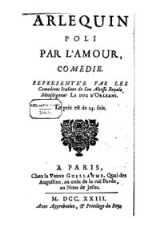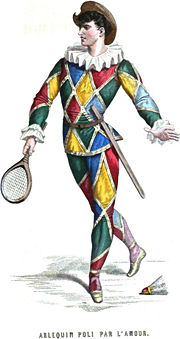
Arlequin poli par l'amour
Encyclopedia
Arlequin poli par l'amour is a one-act romantic
comedy
by French
playwright Marivaux
. Its title could be translated into English as Harlequin, refined by love. Arlequin poli par l'amour was first performed 17 October 1720 by the Comédie Italienne. In this play, a fairy tries to force Arlequin to fall in love with her. Instead, Arlequin falls in love with Silvia, a shepherdess. With the help of the fairy's servant Trivelin, the two manage to trick the fairy and live happily ever after.
Its plot and comedic features were strongly influenced by the traditional Italian theatre of the Commedia dell'arte
. Arlequin
and Trivelin are stock characters of the Commedia dell'arte, and Silvia is a name associated with the female romantic lead.
Marivaux makes use of several traditional lazzi
as well. For example, near the beginning of the play, Arlequin tries to catch invisible flies while the fairy is trying to have a serious conversation with him. At the end, Arlequin uses the fairy's magic wand to beat all of the characters on stage. (Arlequin and his baton are the origin of the term "slapstick".)
 Having transported a sleeping Arlequin to her island, the fairy
Having transported a sleeping Arlequin to her island, the fairy
waits for him to awake. Her servant, Trivelin, questions her devotion to the young man who is too lazy, too gourmand
, and too simple to be worthy of her love. Moreover, he reminds the fairy that she is engaged to Merlin, a powerful sorcerer, and breaking the engagement could have serious consequences. When Arlequin wakes up, the fairy indulges him with romantic entertainment, but he is more concerned with a ring she wears on her finger and being fed.
Arlequin, having left the fairy's palace, stumbles upon Silvia in the forest, and the two of them fall instantly in love. Silvia gives Arlequin her handkerchief, and they agree to meet later on that evening. Back at the palace, the fairy's suspicions are aroused when Arlequin suddenly begins showing manners and acting civilized; and when she spies the handkerchief, she assumes the transformation has occurred because of love. She follows him into the forest and catches Arlequin and Silvia together. She separates the lovers and forces Silvia to tell Arlequin that she is really engaged to a shepherd from the village; the fairy also sends Trivelin to spy on them to make sure that Silvia does not disobey.
Upon hearing Silvia's lie, Arlequin threatens to kill himself. Silvia tells him the truth about the fairy's demands; and Trivelin reveals himself to the couple. However, Trivelin takes pity on Arlequin and Silvia and gives them advice on how to trick the fairy. Arlequin then pretends to reject Silvia and returns to the fairy. When he is close enough, he steals the fairy's magic wand and forces her to become his servant. Arlequin and Silvia decide to get married.
Dansers, Singers, and Spirits
Romantic Comedy
Romantic Comedy can refer to* Romantic Comedy , a 1979 play written by Bernard Slade* Romantic Comedy , a 1983 film adapted from the play and starring Dudley Moore and Mary Steenburgen...
comedy
Comedy
Comedy , as a popular meaning, is any humorous discourse or work generally intended to amuse by creating laughter, especially in television, film, and stand-up comedy. This must be carefully distinguished from its academic definition, namely the comic theatre, whose Western origins are found in...
by French
French people
The French are a nation that share a common French culture and speak the French language as a mother tongue. Historically, the French population are descended from peoples of Celtic, Latin and Germanic origin, and are today a mixture of several ethnic groups...
playwright Marivaux
Pierre de Marivaux
Pierre Carlet de Chamblain de Marivaux , commonly referred to as Marivaux, was a French novelist and dramatist....
. Its title could be translated into English as Harlequin, refined by love. Arlequin poli par l'amour was first performed 17 October 1720 by the Comédie Italienne. In this play, a fairy tries to force Arlequin to fall in love with her. Instead, Arlequin falls in love with Silvia, a shepherdess. With the help of the fairy's servant Trivelin, the two manage to trick the fairy and live happily ever after.
Its plot and comedic features were strongly influenced by the traditional Italian theatre of the Commedia dell'arte
Commedia dell'arte
Commedia dell'arte is a form of theatre characterized by masked "types" which began in Italy in the 16th century, and was responsible for the advent of the actress and improvised performances based on sketches or scenarios. The closest translation of the name is "comedy of craft"; it is shortened...
. Arlequin
Harlequin
Harlequin or Arlecchino in Italian, Arlequin in French, and Arlequín in Spanish is the most popularly known of the zanni or comic servant characters from the Italian Commedia dell'arte and its descendant, the Harlequinade.-Origins:...
and Trivelin are stock characters of the Commedia dell'arte, and Silvia is a name associated with the female romantic lead.
Marivaux makes use of several traditional lazzi
Lazzi
Lazzi is an improvised comic dialogue or action commonly used in the Commedia dell'arte. Most English-speaking troupes use the Italian plural "lazzi" as the singular and "lazzis" for the plural....
as well. For example, near the beginning of the play, Arlequin tries to catch invisible flies while the fairy is trying to have a serious conversation with him. At the end, Arlequin uses the fairy's magic wand to beat all of the characters on stage. (Arlequin and his baton are the origin of the term "slapstick".)
Plot summary

Fairy
A fairy is a type of mythical being or legendary creature, a form of spirit, often described as metaphysical, supernatural or preternatural.Fairies resemble various beings of other mythologies, though even folklore that uses the term...
waits for him to awake. Her servant, Trivelin, questions her devotion to the young man who is too lazy, too gourmand
Gourmand
A gourmand is a person who takes great pleasure in food. The word has different connotations from the similar word gourmet, which emphasises an individual with a highly refined discerning palate, but in practice the two terms are closely linked, as both imply the enjoyment of good food.An older...
, and too simple to be worthy of her love. Moreover, he reminds the fairy that she is engaged to Merlin, a powerful sorcerer, and breaking the engagement could have serious consequences. When Arlequin wakes up, the fairy indulges him with romantic entertainment, but he is more concerned with a ring she wears on her finger and being fed.
Arlequin, having left the fairy's palace, stumbles upon Silvia in the forest, and the two of them fall instantly in love. Silvia gives Arlequin her handkerchief, and they agree to meet later on that evening. Back at the palace, the fairy's suspicions are aroused when Arlequin suddenly begins showing manners and acting civilized; and when she spies the handkerchief, she assumes the transformation has occurred because of love. She follows him into the forest and catches Arlequin and Silvia together. She separates the lovers and forces Silvia to tell Arlequin that she is really engaged to a shepherd from the village; the fairy also sends Trivelin to spy on them to make sure that Silvia does not disobey.
Upon hearing Silvia's lie, Arlequin threatens to kill himself. Silvia tells him the truth about the fairy's demands; and Trivelin reveals himself to the couple. However, Trivelin takes pity on Arlequin and Silvia and gives them advice on how to trick the fairy. Arlequin then pretends to reject Silvia and returns to the fairy. When he is close enough, he steals the fairy's magic wand and forces her to become his servant. Arlequin and Silvia decide to get married.
Characters
- The fairy - a powerful sorceress, engaged to MerlinMerlinMerlin is a legendary figure best known as the wizard featured in the Arthurian legend. The standard depiction of the character first appears in Geoffrey of Monmouth's Historia Regum Britanniae, written c. 1136, and is based on an amalgamation of previous historical and legendary figures...
, but in love with Arlequin. - Trivelin - the fairy's servant
- ArlequinHarlequinHarlequin or Arlecchino in Italian, Arlequin in French, and Arlequín in Spanish is the most popularly known of the zanni or comic servant characters from the Italian Commedia dell'arte and its descendant, the Harlequinade.-Origins:...
- a comedic young man who loves Silvia and is loved by the fairy - Silvia - a beautiful shepherdess
- A shepherd - a young man who loves Silvia but is ultimately rejected in favor of Arlequin
- A shepherdess - Silvia's cousin
Dansers, Singers, and Spirits
External links
- Arlequin poli par amour, in French from the Bibliothèque Nationale
- Arlequin poli par l’amour, in French, on the website CÉSAR

